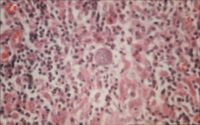Systemic Mycoses
Jump to navigation
Jump to search
| This article is still under construction. |
|
|
Coccidioidomycosis
- Coccidioides immitis
- Ocurs in the soil
- Respiratory infections
- Most commonly seen following dust storms
- Occurs in arid regions
- E.g. South West USA and Mexico
- Non-contageous, systemic mycosis
- Affects dogs, cattle, sheep and humans
- Mainly affects the lungs
- Dissemination can occur to other organs
- Causes nodule or granuloma formation
- Thick-walled spherules in tissue
- Large sporangia burst leaving 'ghost' spherules
- Saprophytic phase consists of coarse, septate, branching hyphae which fragment into thick-walled, barrel-shaped arthrospores which alternate with empty cells
- Stained by Lactose Phenol Cotton Blue
- Grows on Sabouraud's Dextrose agar and Blood agar
- Flat, moist colonies which develop a coarse, cotton-like aerial mycelium which varies from white to brown in colour
- Complement fixation test, latex agglutination and immunodiffusion tests can all be used
- A positive skin test indicates exposure
Entomophthoromycisus
- Basidiobolmycosis
- Caused by Basidiobolus and Conidiobulus fungi
- Causes ulcerative granulomas in subcutaneous tissue
- Affects the oral and nasal mucous membranes
- Basidiobolus causes large lesions which may involve skin on the head, neck and chest
- Fistulous tracts
- Extends to lymph nodes
- Produce flat, waxy colonies which become white and fizzy over time
- Microscopically:
- Septate hyphae
- Treatment:
- Surgical excision
- Amphotericin B or Ketoconazole
Histoplasmosis
- Histoplasma capsulatum
- Non-contageous, systemic mycosis
- Commonly pulmonary infections occur
- Other organs can be involved
- Involves the reticuloendothelial system
- Intestinal form can also occur
- Acute and chronic disease can occur
- Endemic to the USA
- Isolated cases have been reported in Europe
- Respiratory infection
- Infection via ingestion can also occur
- Affects dogs, cats, cattle, horses and humans
- Found in soil contaminated by bird droppings, decaying vegetation and in caves inhabited by bats
- Fine, branching, septate hyphae with smooth-walled pyriform to spherical microconidia and large, thick-walled tuberculate macroconidia on simple conidiophores
- Dimorphic fungi
- Hard to demonstrate in smears as the organisms is very small
- Stain with Giemsa or Wright and examine under oil immersion lens
- Present intracellularly in macrophages as oval yeast cells with few buds
- Clear halo is seen around the darker staining central material
- Grows on Sabouraud's Dextrose agar
- Creamy white colonies, turning tan coloured and then brown
- Also grows on Blood agar
- Small, white yeast-like colonies
- Test using immunodiffusion, complement fixation and counterimmunoelectrophoresis
- Skin test of little value as it only indicates exposure
- Treatment with Amphotericin B
- If Amphotericin B is contra-indicated, imidazoles can be given orally
- The prognosis is poor in acute and disseminated cases
Zygomycosis
- Also known as mucormycosis, hyphomycosis and phycomycosis
- Caused by strains of Mucor, Absidia, Rhizopus and Mortierella
- Mucor circinelloides(rare), Rhizomucor pusillus and R. meihi
- Absidia corymbifera often causes zygomycosis in cattle and pigs
- Rhizopus arrhizus, R. microsporus and R. rhizopodormis
- Mortierella wolfi implicated in bovine abortion (mycotic placentitis), M. hygrophila in fowl and M.polycephala in cattle
- Occurs widely in nature
- Infection is by inhalation and ingestion
- Infects lymph nodes of the respiratory and alimentary tract
- Lymph nodes enlarge and become caseous
- Can cause stomach and intestinal ulcers
- Granulomatous lesions which can ulcerate
- Mostly localised lesions but can be generalised
- Pigs
- Mediastinal and submandibular lymph nodes lesions
- Embolic tumours in the liver and lungs
- Can also be present in gastric ulcers
- Cattle
- Bronchial, mesenteric and mediastinal lymph nodes lesions
- Ulcers of the nasal cavity and abomasum also occur
- Often contaminate the placenta
- Horses, dogs, cats, sheep, mink, guinea-pigs and mice can also be infected
- Microscopically:
- Fragments of non-septate hyphae which are branched and coarse
- Rhizomucor produce a thick, grey mycelium and have short, black, spherical sporangia
- Mucor produce thick, colourless mycelium with no rhizoids. Globose spoangia with small spores are present and sporagiospores are simple or branched.
- Absidia resemble Rhizopus grossly
- Mortierella produce white, velvet colonies on Sabouraud's Dextrose and Blood agar
- Grows on Sabauraud's Dextrose agar
- Common contaminants
- Treatment is with Amphotericin B
- Surgery is also an option in treatment










